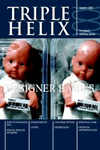Two controversial designer baby cases have recently aroused public controversy. Peter Saunders asks how far we should allow the new gene technology take us.
On Tuesday 8 April the Court of Appeal gave the goahead for the Hashmi family to have a child by in vitro fertilisation in order to provide a 'life-saving' bone marrow transplant for their son Zain, who has B-thalassemia major. The ruling overturned a December 2002 High Court judgement in favour of 'Comment on Reproductive Ethics' (CORE) and was widely applauded in the press, and in particular by the Human Fertilisation and Embryology Authority (HFEA) and the British Medical Association (BMA).
More recently on 16 June Britain's first 'designer baby' was born in Sheffield. Michelle and Jayson Whitaker's baby Jamie was genetically selected in a Chicago Clinic, whilst still an embryo, to be a near perfectly matched blood stem cell donor for his four-year old brother Charlie who suffers from Diamond-Blackfan Anaemia. The HFEA had earlier opposed the Whittakers having embryo selection in the UK on the grounds that it would not directly benefit the selected embryo, and stood by its earlier decision, this time unsupported by the BMA.
Media and public opinion seemed to be strongly behind the parents in both cases; but there were several things that disturbed me.
First, I was concerned by the way public opinion was manipulated by selective and inaccurate reporting of the medical facts. The impression given by the media, that both Zain Hashmi and Charlie Whittaker would die soon without the transplants and that the transplants would be straightforward and uncomplicated, was quite misleading.
There is no doubt that both B-thalassemia and Diamond-Blackfan anaemia (DBA) are serious conditions. Before any treatment was available all sufferers died within a year from the inability to produce red blood cells. Treatment with regular monthly blood transfusions (the only treatment still available in most developing countries) extends life-span to the early teenage years, but then most patients die from the complications of iron deposition. This can be ameliorated with chelation treatment using desferrioxamine, given five times a week by slow subcutaneous infusion (usually over night). This has made possible a median survival of 31 years for DBA and 40- 50 years for B-thalassemia, and results are improving all the time.
Bone marrow transplantation from a tissue-matched donor (almost always a sibling or close family member) for both conditions offers the only chance of a complete cure but there are risks. 5% of patients do not survive the procedure, and a further 10% are not cured; and there are also the long-term risks of debilitating 'graft versus host disease' and the side-effects of immuno-suppressant drugs, which include increased susceptibility to infection and some forms of cancer. Gene therapy may offer further treatment options in the future but not yet. Haematologists themselves remain divided over whether transfusion/chelation or bone marrow transplant is best in any given case; it is by no means clear-cut.
In the Whittaker's case a suitable donor may have already been found (in newborn baby Jamie) although seven embryos of the 'wrong' tissue type were discarded in the selection process and one other that was implanted failed to survive. Ironically it is still possible (up to 25% chance) that Jamie too may turn out to suffer from DBA and that the Whittakers may be left with two children with the condition! For the Hashmi's, only about one in five embryos produced by IVF will be the right HLA tissue type and free of the disease and in a woman of Mrs Hashmi's age the chance of any implanted embryo surviving is around 10% per cycle (with each cycle costing around £2,500). So, in other words, we can expect around 50 embryos, all human lives in their own right, to be discarded or lost for each one that survives. And even then there are difficulties with prenatal screening. Zain himself initially tested normal, and an earlier sibling who was thought to be a good match turned out not to be. Another sibling was aborted when found to have Zain's condition. The rush to conceive a sibling is not because Zain is about to die, but because his mother's biological clock is ticking such that an IVF child will not long be an option.
Second, it is often said that 'hard cases make bad law' and the Hashmi ruling has, I believe, created a very dangerous precedent. Many of us already have severe misgivings about pre-implantation diagnosis, a procedure already legal in this country, whereby human embryos having various disabilities are searched out and destroyed. This seems to strike at the very heart of Christian morality, which decrees that the strong have a duty to protect and respect the weak. It also runs counter to the Declaration of Geneva (1948), which calls doctors to 'maintain the utmost respect for human life from the time of conception even against threat'. After all, what human life is more vulnerable and defenceless than an embryo with special needs? But the Hashmi ruling goes a step further because it has opened the door for human beings to be manufactured for the prime purpose of providing tissue for someone else. It is particularly disturbing that a case where the proposed treatment involves significant mortality (not just for the discarded embryos but also possibly for the sick child) and where the chances of success are so low should have been used to legitimise the highly controversial practice of embryo selection for tissue type.
The Court of Appeal, HFEA and BMA have taken a quantum leap down the slippery slope to 'designer' babies, whereby human embryos can be created and discarded for increasingly trivial reasons. The Hashmi decision was made in haste in an emotionally charged atmosphere where a proper objective consideration of the facts of the case and consequences of the judgement was well-nigh impossible. I am convinced that we will come to regret it.
































